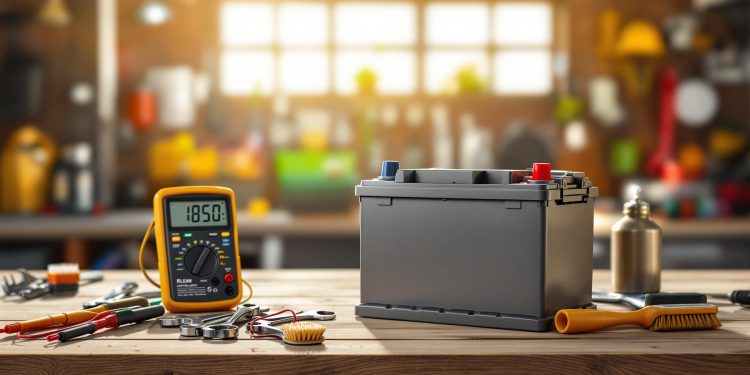Want to make your car battery last longer? Here are 7 simple tips to help you extend its life, especially in South Africa’s challenging climate:
- Clean Battery Terminals: Prevent corrosion by cleaning terminals monthly, especially in coastal areas.
- Monitor Battery Fluid Levels: Regularly check and refill with distilled water to avoid damage.
- Reduce Electronics Use When Parked: Turn off lights and unplug devices to minimize unnecessary drain.
- Guard Against Weather Extremes: Park in shaded areas during summer and use insulators in colder regions.
- Use Battery Chargers for Stored Cars: Maintain charge during long idle periods with smart battery maintainers.
- Keep Battery Firmly in Place: Secure your battery to avoid damage from vibrations on rough roads.
- Avoid Multiple Short Trips: Combine errands to give the alternator enough time to recharge the battery.
7 Things That Will Make Your Car Battery Last Over 5 Years
1. Clean Battery Terminals
Dirty or corroded battery terminals can seriously hurt your battery’s performance and lifespan. Corrosion not only disrupts the electrical system but can also lead to early battery failure if ignored.
What Causes Corrosion
Corrosion on battery terminals happens due to chemical reactions. When a battery charges and discharges, it releases small amounts of hydrogen gas. This gas reacts with nearby materials, creating corrosion over time [3]. Experts say corroded terminals can increase electrical resistance by up to 300% [1], which drastically reduces efficiency.
How to Clean Terminals
Follow these steps to clean your battery terminals effectively:
Safety First
Always wear gloves and safety glasses before starting. Disconnect the cables, beginning with the negative terminal.
What You’ll Need:
- Baking soda and water solution
- Wire brush and clean cloth
- Petroleum jelly or terminal spray
Step-by-Step Process:
- Mix one tablespoon of baking soda with one cup of water [2].
- Disconnect the cables, starting with the negative terminal, then the positive [5].
- Apply the baking soda solution to neutralize any acid on the terminals.
- Scrub the terminals with a wire brush, rinse with water, and dry thoroughly.
- Apply a thin layer of petroleum jelly or a terminal protector spray to prevent future corrosion.
- Reconnect the cables, starting with the positive terminal, followed by the negative.
If you live in coastal areas where humidity is high, consider cleaning the terminals monthly to prevent corrosion from building up.
"Regular terminal cleaning can improve charging system efficiency by up to 50%", according to a study by the Battery Council International [8].
Keeping your terminals clean also helps maintain proper battery fluid levels, which we’ll cover next. This simple maintenance step lays the groundwork for better overall battery care.
2. Monitor Battery Fluid Levels
Keeping your battery’s fluid levels in check is essential for its overall health. Low fluid levels can expose the lead plates inside, causing irreversible damage and reducing the battery’s capacity. In fact, research indicates that low electrolyte levels can shrink a battery’s capacity by as much as 30% [11].
Checking Fluid Levels
Start by identifying the type of battery you have: standard or maintenance-free. Maintenance-free batteries are sealed and should never be opened. For standard batteries with removable caps, follow these steps safely and carefully.
What You’ll Need:
- Safety goggles
- Rubber gloves
- A clean cloth
- Distilled water
Steps to Inspect and Refill:
- Park your vehicle on a flat surface, turn off the engine, and open the hood.
- Carefully remove the cell caps from the battery.
- Check that the electrolyte fully covers the metal plates.
- If the plates are exposed, add distilled water until the fluid level is about 1/4 to 1/2 inch below the top of the cell [2].
"Regular monitoring of battery fluid levels can extend a battery’s lifespan by up to 50% compared to neglected batteries", according to research [1].
Key Tips and Warning Signs
- Always use distilled water – tap or filtered water can damage the battery [6].
- Watch for warning signs like slow engine cranking, dim headlights, or flickering dashboard lights [5].
Proper fluid maintenance not only prevents damage but also ensures your battery performs at its best. Up next: how to reduce electrical drains for even better battery care.
3. Reduce Electronics Use When Parked
Even when parked, cars continue powering electronics, which can drain the battery. For reference, a typical car battery holds around 60 amp-hours: headlights can deplete it in just 2-3 hours, while a car stereo might take 10-12 hours [1].
Prevent Battery Drain
To keep your battery in good shape, managing power usage is key.
Devices to Keep an Eye On:
- Interior and exterior lights, as well as infotainment systems
- USB charging ports
- Dash cams and GPS units
- Add-on accessories like aftermarket lighting or audio systems
Most vehicles maintain a background power draw of 50-85 milliamps for essentials like security systems and clock memory [1].
Steps to Avoid Unnecessary Drain:
For short-term parking:
- Double-check that lights are off, unplug any devices, and turn off electronics before leaving the car.
For long-term storage:
- Install a battery disconnect switch to cut power to non-essential systems.
- Use a smart battery maintainer to keep the battery charged.
- If parked outdoors, consider a solar-powered maintainer to help sustain charge levels.
Although many systems have auto-shutoff features, it’s always better to manually confirm everything is off. This is especially important in regions like South Africa, where load-shedding can increase accessory use during power outages, leading to faster battery drain.
Managing power usage effectively is even more important when paired with weather protection strategies – coming up next.
4. Guard Against Weather Extremes
Extreme temperatures can shorten your car battery’s life. According to AA South Africa, batteries in hot climates tend to last 2-3 years, compared to 4-5 years in milder conditions [1]. Knowing how to shield your battery from harsh weather can make a big difference.
Protection from Heat
High temperatures speed up chemical reactions inside batteries, especially in areas like the Northern Cape and Gauteng. Research from the Council for Scientific and Industrial Research (CSIR) found that parking in the shade can lower a car’s interior temperature by as much as 25°C compared to parking in direct sunlight [2].
Tips to Protect Against Heat:
- Park in shaded or covered areas whenever you can.
- Use a battery insulation kit to reduce heat exposure.
- Check fluid levels more often during summer.
- Keep the battery and its surroundings clean to avoid extra heat buildup.
Cold Weather Care
Even though South Africa is mostly warm, places like the Free State have cold spells that can impact battery performance. At 0°C, a car battery can lose up to 35% of its strength [2].
Tips for Winter Battery Care:
- Use a battery blanket or insulator on cold nights.
- Keep your battery fully charged during colder months.
- Opt for batteries with higher Cold Cranking Amps (CCA) for better performance in low temperatures.
Regional Guide for Battery Protection:
- Coastal areas: Apply terminal coatings monthly to prevent corrosion.
- Hot inland regions: Use battery insulation kits.
- High-altitude areas: Choose batteries with higher CCA ratings.
- Colder regions: Make sure your battery stays fully charged.
5. Use Battery Chargers for Stored Cars
When your car is sitting idle for long periods – like during load-shedding or remote work – your battery can lose around 1% of its charge daily [10]. To avoid a dead battery when you need your car, it’s smart to use a battery maintainer.
Battery Charger Basics
Modern battery maintainers are designed to keep your battery in good condition without the risk of overcharging. They use microprocessors to monitor the battery and adjust the charge automatically. Once the battery is fully charged, the maintainer switches to "float mode", supplying just enough power to offset natural discharge.
What to Look for in a Battery Maintainer:
| Feature | Why It’s Important |
|---|---|
| Adaptive charging | Prevents overcharging |
| Auto-voltage detection | Protects against incorrect settings |
| Reverse polarity protection | Avoids damage from wiring mistakes |
| Weather-resistant design | Safe to use in different environments |
| Clear status lights | Lets you monitor the charging process |
Experts at ImotoNews South Africa suggest choosing a maintainer with temperature compensation to handle the country’s climate variations. Using a high-quality maintainer can extend your battery’s lifespan by up to 50% [5].
Safety Tips for Charging:
- Ensure the area is well-ventilated to avoid hydrogen gas buildup.
- Keep the maintainer away from heat sources and moisture.
- Check that the maintainer is compatible with your battery type.
For best results, connect the maintainer before storing your car and leave it connected during the entire storage period. This is especially helpful during extended load-shedding. It prevents sulfation – a process where crystals form and reduce battery efficiency – so your car will start smoothly when you need it [1].
Taking care of your battery during storage is just one part of the equation. The next step is making sure it’s physically secure.
sbb-itb-09752ea
6. Keep Battery Firmly in Place
Securing your car’s battery is essential for its longevity, especially given the varied road conditions in South Africa. A well-mounted battery can last over two years longer than one that’s loose [1]. On the other hand, a poorly secured battery may fail early due to internal damage caused by constant movement.
Check Battery Mount
A reliable mounting system includes several key components that help prevent vibration and movement:
| Component | What to Look For |
|---|---|
| Battery Tray | Inspect for rust or cracks that weaken support. |
| Hold-down Clamp | Ensure it makes proper, centered contact. |
| J-bolts/Tie-downs | Check for correct tension to hold the battery securely. |
| Rubber Insulator | Confirm it’s intact for vibration dampening. |
Signs Your Battery Might Be Loose:
- Unusual rattling noises from the engine bay.
This is especially concerning on South Africa’s mix of smooth highways and rough rural roads, where vibrations can quickly damage an unsecured battery [1].
How to Inspect
- Test for movement: The battery should feel solid and not wiggle.
- Check clamps and insulators: Look for wear or damage.
- Verify terminal connections: Tighten if needed, but avoid adjusting any attached sensors.
Pro Tip: Use a torque wrench when tightening the battery mounts. Over-tightening can crack the battery case, so always refer to your vehicle’s manual for the correct specifications.
Once your battery is secure, pairing it with smart driving habits can help maintain its charge. Stick around for our final tip to learn more!
7. Avoid Multiple Short Trips
Taking frequent trips under 20 minutes can significantly reduce battery life because the engine doesn’t run long enough to fully recharge the battery after starting [1]. This is especially important in cities like Johannesburg and Cape Town, where 63% of commutes are under 15km, according to Stats SA [3].
When you take short drives, the alternator (which outputs 13.5-14.8V) doesn’t have enough time to restore the energy used to start the engine [1]. Over time, this leads to a gradual loss of battery power, making it weaker and less reliable.
Plan Your Drives
Careful planning can help protect your car battery. Instead of making multiple short trips, try combining errands into one longer drive. Here are a few tips:
- Group errands by location to minimize travel time.
- Aim for at least 30 minutes of continuous driving when possible.
- Plan your routes to make the most of your commute.
If your vehicle is used primarily for short trips, a battery maintainer or trickle charger can help. These tools provide extra charging support, compensating for the limited time your alternator has to recharge the battery during brief drives [4].
Pro Tip: If short trips are unavoidable, try to include a weekly drive lasting 30–60 minutes to keep your battery in good shape.
Using these strategies alongside regular battery care ensures your car stays reliable. Next, we’ll explore how choosing the right battery can extend its lifespan.
Standard vs. No-Maintenance Batteries
Picking the right battery type is key, especially in South Africa’s tough driving conditions. Each option comes with unique features that impact durability, cost, and upkeep.
Standard batteries have removable caps, allowing you to check and refill fluids, but they require regular attention. On the other hand, maintenance-free batteries are sealed and use advanced plate designs to minimize water loss and self-discharge. This makes them particularly useful in areas like the Northern Cape and Limpopo, where extreme heat is common [4].
For regions with harsh climates, maintenance-free batteries offer better protection against evaporation and weather-related wear [5]. Their sealed design also suits vehicles with higher electronic demands (as mentioned in Section 3).
Battery Comparison Chart
| Feature | Conventional Batteries | Maintenance-Free Batteries |
|---|---|---|
| Maintenance Required | Yes | No |
| Longevity | Moderate | Longer |
| Cost | Lower | Higher |
| Ideal for South Africa | Good for older vehicles | Best for modern vehicles |
These choices tie into earlier strategies for dealing with regional challenges. Maintenance-free batteries shine in areas with extreme heat and dust. They also perform well during load-shedding (covered in Section 5) by holding a charge longer when not in use [9].
"Maintenance-free batteries often perform better due to their sealed design, which protects against extreme temperatures and dust", states a recent industry report [5].
Pro Tip: Maintenance-free batteries are a better match for modern vehicles, while older models can still rely on conventional options effectively.
Conclusion
By following these seven maintenance tips, South African drivers can help their car batteries last longer than the usual 3–5 years [1]. Keeping up with these habits ensures your vehicle runs smoothly, no matter the conditions.
This guide shows how taking care of your battery can save on repair costs and keep your car dependable. Knowing and practicing these steps makes a big difference in extending battery life.
Here’s a quick look at seasonal care to keep your battery in top shape across South Africa’s varied climates:
| Season | Key Focus |
|---|---|
| Summer | Check fluid levels |
| Winter | Clean and maintain terminals |
| All Year | Perform voltage tests |
For more detailed, location-specific tips, check out ImotoNews South Africa. Their guides provide step-by-step advice to put these practices into action.
Pro Tip: Sync your battery maintenance with your vehicle’s regular service schedule to keep everything running smoothly year-round.
South African Car Care Resources
To put these strategies into action, take advantage of these local resources:
ImotoNews South Africa provides maintenance guides tailored to the unique challenges of the country’s regions. Here’s a quick breakdown of common battery issues by area:
| Region | Common Battery Issues |
|---|---|
| Gauteng | Exposure to extreme heat |
| Coastal Areas | Corrosion from salty air |
| Free State | Harsh winter temperatures |
In collaboration with AUTO24.co.za, they also offer:
- Free battery health checks at dealerships in Gauteng and Cape Town
- Help with selecting the right battery for specific car models
ImotoNews also provides a directory of certified battery specialists in major cities. For vehicle storage, they recommend using smart battery maintainers [1].
DIY Maintenance Tips
ImotoNews shares practical advice for maintaining and caring for car batteries using products that are easy to find locally [1].
For more details on how to apply these maintenance strategies in your region, check out ImotoNews South Africa. Their team frequently highlights new solutions tailored to the South African market.
FAQs
What can I put in my battery to make it last longer?
Stick to distilled water – never use tap water or any additives. This rule applies to standard batteries with removable caps [7].
Here are key steps to follow:
| Action | Details |
|---|---|
| Professional Testing | Test electrolyte specific gravity every 6 months. |
Important: Sealed maintenance-free batteries should never have any fluids added [3].
The focus should always be on prevention through regular checks, not quick fixes or additives.
"Regular battery checks during routine maintenance can prevent up to 70% of battery-related failures in hot climates. The key is prevention rather than trying to extend life through additives." [12]
If problems persist, it might point to an issue with the charging system. In such cases, a professional diagnosis is recommended, as noted in earlier tips.
Related Blog Posts
- Fuel-Saving Tips for Long South African Road Trips
- 7 Winter Car Care Tips for South Africa
- 5 Tips To Save On Fuel Costs In South Africa
- 10 ways to save petrol in South Africa





